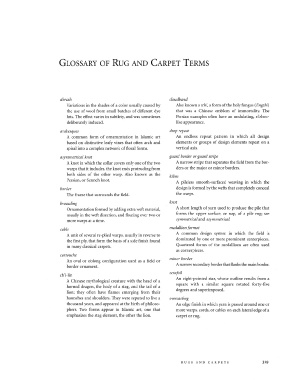Page 335 - Decorative Arts, Part II: Far Eastern Ceramics and Paintings, Persian and Indian Rugs and Carpets
P. 335
GLOSSARY OF RUG AND CARPET TERMS
abrash cloudband
Variations in the shades of a color usually caused by Also known a tchi, a form of the holy fungus (lingzhi)
the use of wool from small batches of different dye that was a Chinese emblem of immortality. The
lots. The effect varies in subtlety, and was sometimes Persian examples often have an undulating, ribbon-
deliberately induced. like appearance.
arabesques drop repeat
A common form of ornamentation in Islamic art An endless repeat pattern in which all design
based on distinctive leafy vines that often arch and elements or groups of design elements repeat on a
spiral into a complex network of floral forms. vertical axis.
asymmetrical knot guard border or guard stripe
A knot in which the collar covers only one of the two A narrow stripe that separates the field from the bor-
warps that it includes, the knot ends protruding from ders or the major or minor borders.
both sides of the other warp. Also known as the kilim
Persian, or Senneh knot.
A pileless smooth-surfaced weaving in which the
border design is formed by the wefts that completely conceal
The frame that surrounds the field. the warps.
brocading knot
Ornamentation formed by adding extra weft material, A short length of yarn used to produce the pile that
usually in the weft direction, and floating over two or forms the upper surface, or nap, of a pile rug; see
more warps at a time. symmetrical and asymmetrical.
cable medallion format
A unit of several re-plied warps, usually in reverse to A common design system in which the field is
the first ply, that form the basis of a side finish found dominated by one or more prominent centerpieces.
in many classical carpets. Quartered forms of the medallions are often used
as cornerpieces.
cartouche
An oval or oblong configuration used as a field or minor border
border ornament. A narrow secondary border that flanks the main border.
octafoil
ch'i-lin
A Chinese mythological creature with the head of a An eight-pointed star, whose outline results from a
horned dragon, the body of a stag, and the tail of a square with a similar square rotated forty-five
lion; they often have flames emerging from their degrees and superimposed.
haunches and shoulders. They were reputed to live a overcasting
thousand years, and appeared at the birth of philoso- An edge finish in which yarn is passed around one or
phers. Two forms appear in Islamic art, one that more warps, cords, or cables on each lateral edge of a
emphasizes the stag element, the other the lion. carpet or rug.
R U G S A N D C A R P E T S 319

